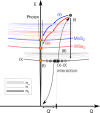Upconverted electroluminescence via Auger scattering of interlayer excitons in van der Waals heterostructures
- PMID: 31133651
- PMCID: PMC6536535
- DOI: 10.1038/s41467-019-10323-9
Upconverted electroluminescence via Auger scattering of interlayer excitons in van der Waals heterostructures
Abstract
The intriguing physics of carrier-carrier interactions, which likewise affect the operation of light emitting devices, stimulate the research on semiconductor structures at high densities of excited carriers, a limit reachable at large pumping rates or in systems with long-lived electron-hole pairs. By electrically injecting carriers into WSe2/MoS2 type-II heterostructures which are indirect in real and k-space, we establish a large population of typical optically silent interlayer excitons. Here, we reveal their emission spectra and show that the emission energy is tunable by an applied electric field. When the population is further increased by suppressing the radiative recombination rate with the introduction of an hBN spacer between WSe2 and MoS2, Auger-type and exciton-exciton annihilation processes become important. These processes are traced by the observation of an up-converted emission demonstrating that excitons gaining energy in non-radiative Auger processes can be recovered and recombine radiatively.
Conflict of interest statement
The authors declare no competing interests.
Figures




References
-
- Pandey AK, Nunzi JM. Upconversion injection in rubrene/perylene-diimide-heterostructure electroluminescent diodes. Appl. Phys. Lett. 2007;90:263508. doi: 10.1063/1.2752540. - DOI
-
- Qian L, et al. Electroluminescence from light-emitting polymer/ZnO nanoparticle heterojunctions at sub-bandgap voltages. Nano Today. 2010;5:384–389. doi: 10.1016/j.nantod.2010.08.010. - DOI
-
- Iveland J, Martinelli L, Peretti J, Speck JS, Weisbuch C. Direct measurement of Auger electrons emitted from a semiconductor light-emitting diode under electrical injection: identification of the dominant mechanism for efficiency droop. Phys. Rev. Lett. 2013;110:177406. doi: 10.1103/PhysRevLett.110.177406. - DOI - PubMed
Publication types
Grants and funding
LinkOut - more resources
Full Text Sources

